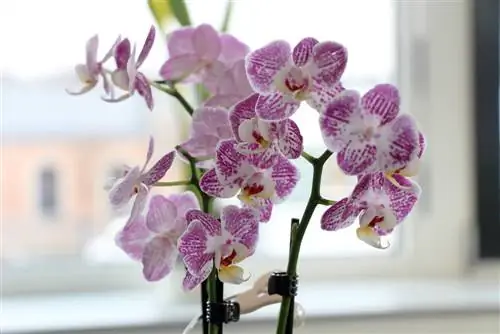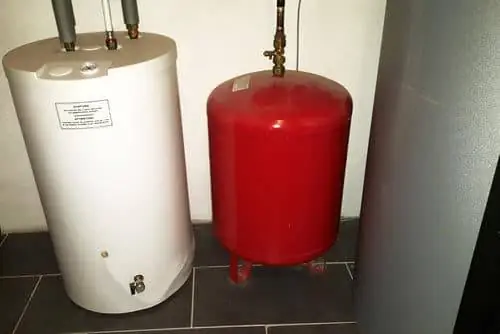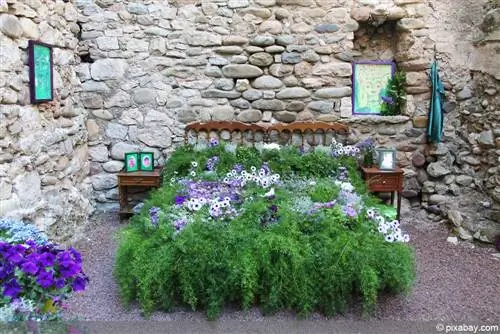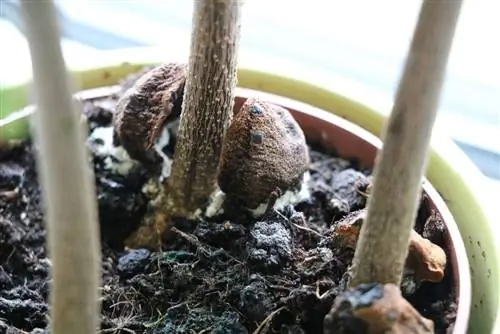- Author admin [email protected].
- Public 2023-12-17 03:39.
- Last modified 2025-06-01 06:48.
Around 30,000 different orchid species are known worldwide, of course not all of which are kept indoors. However, the choice between the cultivated species is also inexhaustible, although the requirements in terms of care and husbandry vary greatly. You can easily cultivate many orchids on the windowsill, others only feel comfortable in special greenhouses with precisely adjusted temperature, brightness and humidity.
Can you grow orchids over a radiator?
In most apartments, the radiators are located directly under the windows. There are practical reasons for this, as the remaining walls are needed for the furniture. The modern heating installation poses problems for many plant lovers, at least in winter: In order for the orchids to get enough light, they have to be placed directly in front of the window - and therefore above the heater.
Since many orchids require high air humidity and a switched-on heating leads to dry room air (which, by the way, is not only harmful to the plants but also the cause of more common colds in winter), this location is of little use optimal.
Nevertheless, you can easily cultivate some types of orchids here as long as you ensure appropriately high humidity. However, more demanding orchids should under no circumstances be kept above the heater: they belong in a special display case.
Which types of orchids are suitable for keeping on the windowsill

The Phalaenopsis is one of the best known - and probably most popular - indoor orchids. It is also known as the butterfly orchid and is available in numerous multi-colored varieties. The Phalaenopsis is considered to be extremely easy to care for and can easily be cultivated over the radiator in winter - provided you ensure sufficient humidity. Other popular and easy-care orchid species that do not mind heating air with appropriate care include these:
- Odontoglossum (optimal temperature between 18 and 24 °C)
- Cattleya (optimal temperature up to 30 °C)
- Paphiopedilum (woman's slipper or Venus' slipper, optimal temperature between 15 to 25 °C)
- Oncidium (optimal temperature between 18 to 22 °C)
- Miltonia or Miltoniopsis (“pansy orchid”, optimal temperature at approx. 20 °C)
- Cambria (easy-care crosses of different species, not above 25 °C)
- Cymbidium (only the smaller varieties are suitable for the windowsill, they require over 60% humidity)
Tip:
Many orchids need slightly cooler temperatures at night in winter - between five to ten degrees difference, depending on the species - so that they can bloom again the following season. Therefore, turn down the heating slightly overnight and check the desired temperature with an indoor thermometer.
These orchids feel most at home in a display case
However, there are a whole range of orchids that do not feel at all comfortable on the windowsill and, at best, need a precisely tempered and illuminated environment. These specimens feel protected in a terrarium (open at the top).most comfortable in a plant display case. A well-known (and popular) example of such more demanding specimens are the Vanda orchids (“Ascocentrum”), which are best cared for without a substrate in a glass vase.
Tip:
Of course, more demanding orchids do not necessarily have to be in a display case or aquarium. You just shouldn't cultivate them directly over a heater - they usually still feel comfortable in another location in the room, as long as you provide sufficient brightness with a plant light.
Why orchids prefer central heating to fireplaces
Until about 40 years ago, many households did not have central heating. Instead, there was a tiled stove in every room, usually in a corner away from the window. These stoves are hard to find these days - instead, wood-fired fireplaces have been enjoying a revival in recent years thanks to rising heating costs. If a room is heated primarily by a stove or fireplace, you should not cultivate orchids in it.
The temperatures in fireplace-heated rooms fluctuate greatly and are difficult to control - conditions that orchids cannot cope with at all. Instead, they need a more or less constant temperature environment with slightly lower temperatures at night. For this reason, central heating that is easier to control is generally recommended for orchid cultivation.
How to tell if your orchid is uncomfortable over the heater
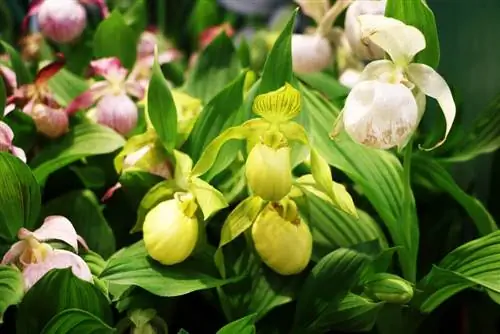
With species-appropriate care and sufficiently high humidity, many orchids can be cultivated over the heater. However, if you notice any of the following signs, your specimen is not comfortable with the chosen location:
- Orchid not blooming
- buds that have already formed are dropped
- Orchid is infested with mealybugs or mealybugs
In particular, an infestation with mealybugs and the loss of buds (not to be confused with the shedding of flowers that have already faded!) are a clear indication that the air in the room is too dry. Both problems can be managed if you significantly increase the humidity. However, the plant no longer even forms buds - i.e. H. It doesn't bloom - so the lack of day and night change or, in some species, the lack of hibernation is usually the cause. The very frequently cultivated Phalaenopsis, for example, needs slightly cooler temperatures at night than during the day - only then will it produce new flowers.
Tip:
If your orchids' leaves hang limply, there are problems with the water supply. In this case, you have either watered the plants too much or too little. However, this phenomenon has nothing to do with the heating or room air that is too dry.
High humidity - but only water moderately
Many plant lovers with ailing orchids make the mistake of confusing the requirement for higher humidity with a more frequent watering interval. The exact opposite is the case! While many types of orchids need to be watered about once a week during the summer months, they need significantly less water in the winter - you only need to use the watering can every ten to 14 days between October and March, and even less often for orchids that overwinter in a cool place. As a rule of thumb: the darker and cooler the orchid is, the less water it needs. The reason for this lies in the plant's slowed metabolism: the roots absorb significantly less water, and less water evaporates through the leaves.
Tip:
Don't stick to rigid watering rhythms, but check before each watering whether the dose is actually necessary. To do this, lift the orchid out of the pot and feel the roots or substrate: If there is residual moisture, you do not need to water it yet. Species cultivated without substrate and as epiphytes (i.e. epiphytes) are not watered anyway, but rather just sprayed.
So your orchids feel comfortable even above the heater
Although you have to water the orchids less in winter, they still need a humidity of at least 60 °C - some species even more. However, experience shows that running a heating system dries out the ambient air significantly - in heated rooms with temperatures between 20 and 22 °C, the humidity is rarely more than 40 °C. If you heat your orchid room even warmer, the humidity will be even lower. This in turn doesn't suit the plants and they start to get sick - even if they don't die straight away. In order for the orchids to stay he althy, you have to artificially increase the humidity. There are different options for this:
- You dry your laundry in the apartment (not recommended, promotes mold growth in the apartment)
- Installing a humidifier (electric or a container with water attached to the heater)
- Evaporation dishes on the windowsill
- Window sill bowls on which the orchids are placed directly
- Spraying the orchids regularly with room temperature water (several times a day)
Tip:
Frequent ventilation (heating off, windows wide open for ten minutes) also increases the humidity and also ensures that stale air is exchanged. Experts recommend ventilating in this way at least two to three times a day during the winter months to avoid mold in the apartment. However, sensitive plants such as orchids do not like the cold draft at all, which is why it is best to move them to another room for a short time before airing them out.
How to make windowsill bowls for your orchids
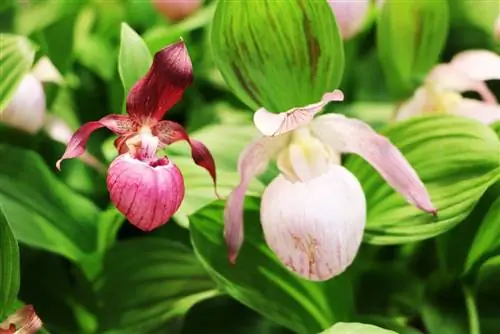
Window sill bowls have proven to be particularly effective for increasing the humidity of orchids grown on the windowsill. Here the air humidity is only locally increased to the desired level so that the plant benefits directly from it. You can buy the appropriate equipment commercially (costs from 15 to 20 EUR depending on size and material), but you can also recreate it relatively easily. All you need is a flat bowl and a grid that you place in the bowl. Pour water into the bowl so that the grid is covered. Place the orchid and its planter on it (important because the plant must not get its feet wet!).
The warm air from the heating causes the water to gradually evaporate and the humidity increases to the required level directly on the orchid. Depending on the room temperature and size of the window sill shell, you will need to refill it every few days, but at the latest every two to three weeks. Instead of a grid, you can also use expanded clay balls (like for hydroponics) and instead of a flat bowl, you can use another planter that is two to three sizes larger (the bottom of which you fill a few centimeters thick with the expanded clay). This system is particularly suitable for orchids that need to be kept a little cooler - the evaporating water also cools the roots.
Tip:
The window sill bowl should be cleaned thoroughly before each refill, otherwise fungi and bacteria will settle in it after some time. These in turn have potentially harmful effects on your plants as well as yourself (mold!) and any pets you may have.

